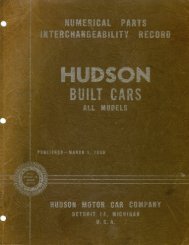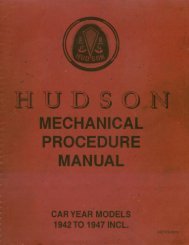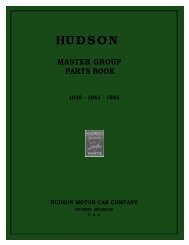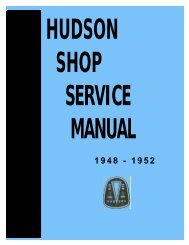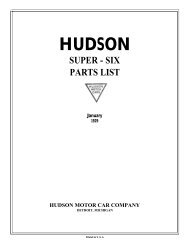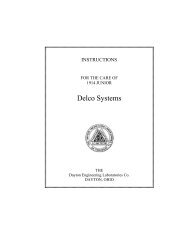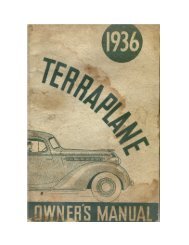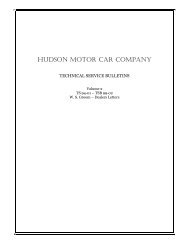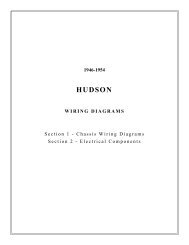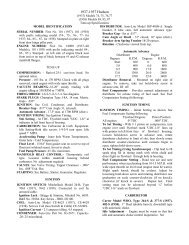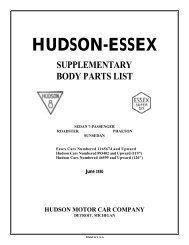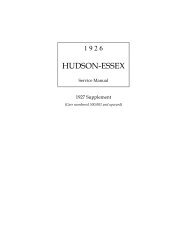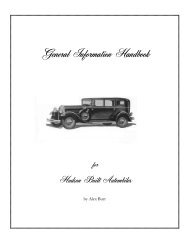1956 AMC Hudson Technical Service Manual Supplement
1956 AMC Hudson Technical Service Manual Supplement
1956 AMC Hudson Technical Service Manual Supplement
You also want an ePaper? Increase the reach of your titles
YUMPU automatically turns print PDFs into web optimized ePapers that Google loves.
HYDRA-MATIC TRANSMISSION 101<br />
TESTING AND DIAGNOSIS<br />
"STALL" OR TORQUE TEST<br />
A "Stall" or Torque test may be made to determine<br />
engine and transmission performance. This test must be<br />
used with moderation because considerable strain is<br />
exerted on the drive line, differential gears, and axles.<br />
To perform "Stall" test, proceed as follows:<br />
Start engine and warm up to operating temperature.<br />
Connect electric tachometer.<br />
Set hand brake lever tightly and apply foot brake<br />
firmly.<br />
Place selector lever in "D" position.<br />
Depress accelerator pedal to floor.<br />
Action has placed transmission in first speed. Brakes<br />
are applied, therefore the car cannot move. Opening the<br />
throttle and speeding up the engine is comparable to<br />
slipping a mechanical clutch, as the driving torus is<br />
turning and trying to turn the driven torus which is held<br />
stationary by the transmission being in first speed and<br />
brakes locked.<br />
The engine will speed up until the friction created<br />
between the torus members equals the power output of<br />
the engine. Engine speed will denote efficiency and<br />
should compare to specifications outlined in Figure 146.<br />
If engine R.P.M. is less than the low limit, the engine<br />
is in need of a tune-up.<br />
If engine continues to speed up to approximately 200<br />
to 350 R.P.M. above the high limit, it indicates that<br />
clutch sprags are not holding properly or that there is<br />
slippage in fluid coupling, damaged torus members, or<br />
defective front pump.<br />
CAUTION: Extreme care must be used in making<br />
this test. DO NOT HOLD THROTTLE OPEN<br />
MORE THAN ONE MINUTE. If engine speeds up<br />
to 350 R.P.M. over specifications, close throttle<br />
immediately to avoid possible damage to transmission.<br />
Sometimes, it is desirable to know which unit is<br />
slipping. After making test with selector lever in "D"<br />
position, place lever in "R" position and test again. If<br />
slippage still occurs, fault is with front unit or both. If<br />
slippage does not occur, then all slippage is in the rear<br />
unit. Since this transmission starts in 1st speed in "L"<br />
range, the stall speed should be exactly the same in "L"<br />
range as it is in Drive and Reverse.<br />
Check Cause for Slipping Under "Stall Test"<br />
Set hand brake lever tightly.<br />
Start engine and run at a speed equivalent to 20 M.P.H<br />
for approximately 11/2 minutes. Then, with engine<br />
IDLING, selector lever in "N" range, check the fluid<br />
level in the transmission.<br />
See that fluid is at the "Full" mark on the indicator.<br />
After level has been checked, shut off engine and<br />
wait 10 minutes. If the fluid level in the transmission<br />
has not raised more than 1/2", the driven torus check<br />
valve is operating satisfactorily.<br />
If check valve is operating satisfactorily, road test<br />
car using Diagnosis Guide.<br />
OIL PRESSURE TEST<br />
Connect oil pressure gauge j-2540 to take-off hole at<br />
bottom of rear pump using hose and fitting.<br />
Start engine and operate for several minutes to warm<br />
transmission oil to normal operating temperature<br />
(approx. 175°F.).<br />
When transmission is thoroughly warm, check pressure<br />
in all ranges. Pressure should be 50 lbs. minimum<br />
in "P," "N," D-4, D-3, and "L" ranges with a maximum<br />
variation of 10 lbs. between ranges. The pressure,<br />
however, may be higher in reverse.<br />
Check pressure in D-3 position at approximately 25<br />
M.P.H. while driving car. Pressure should be 90-100<br />
P.S.I.<br />
NOTE: Pressure at any speed is constant regardless<br />
of throttle position. T.V. pressure is<br />
not used to modulate line pressure.<br />
While driving at 25 M.P.H., move selector lever<br />
back to D-4 position so transmission will shift into<br />
fourth speed. Oil pressure should drop to 60-70 P.S.I.<br />
in fourth speed.<br />
NOTE: To reduce the amount of work done by<br />
the front pump, pressure is directed from the<br />
3-4 shift valve to the pressure regulator to<br />
reduce line pressure in fourth speed when in<br />
D-4 position. In D-3 position, line pressure<br />
remains at 90-100 P.S.I. in fourth speed.<br />
To check pressure in reverse, stop car and set hand<br />
brake firmly. Then place selector lever in "R" range<br />
and apply foot brake and open accelerator to half<br />
throttle. Pressure should increase to 145-190 P.S.I.<br />
Diagnosis of malfunctions can frequently be aided<br />
by noting oil pressure under all operating conditions<br />
while driving on the road.<br />
ROAD TEST<br />
A road test can be made using the shift speed chart in<br />
Figure 146. It will be observed, however, that the<br />
closed throttle downshifts in D-4 and the 3-2 downshift<br />
in D-3 cannot be distinguished. The reason is that in<br />
D-4, the sprags in both



